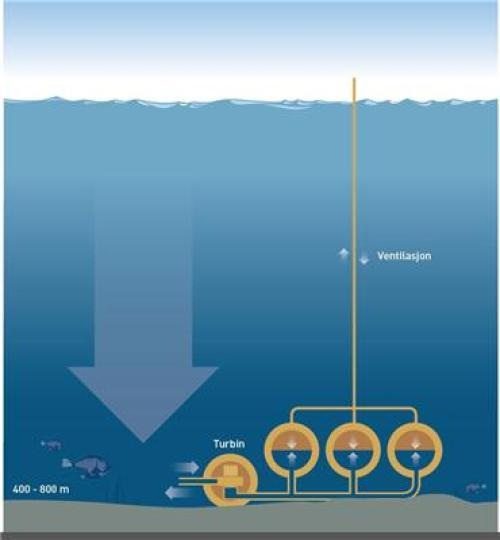By Nathan
Storing electricity at the bottom of the ocean? The idea may sound strange at first, but the new concept from the German engineer Rainer Schramm could be very effective — with an efficiency of around 80%, comparable to conventional energy storage systems. The energy storage system makes use of the pressure differential between the seafloor and the ocean surface.
It’s not a new idea, either, with Lockheed Martin making use of temperature differences between ocean levels to create energy.
Image Credit: Illustration by Knut Gangåssæter/Doghouse
“Imagine opening a hatch in a submarine under water. The water will flow into the submarine with enormous force. It is precisely this energy potential we want to utilize,” says Rainer Schramm, inventor and founder of the company Subhydro. “Many people have launched the idea of storing energy by exploiting the pressure at the seabed, but we are the first in the world to apply a specific patent-pending technology to make this possible.”
In order to do that, Schramm has joined forces with SINTEF, with the aim of developing the concept. “SINTEF has experts in the fields of energy generation, materials technology and not least offshore and deep-water technology, which means we have all the expertise we need in one place.”
“A pumped storage power plant is a hydroelectric plant which can be ‘charged’ up again by pumping the water back to the upper reservoir once it has passed through a turbine. This type of power plant is used as a ‘battery’, when connected to the power grid.”
In the new design, the pumped storage power plant turbine will be integrated with a storage tank located on the seabed at a depth of around 400-800 meters. The way that it works is: the turbine is equipped with a valve, and whenever the valve is opened water flows in and turns the turbine. This turbine then powers a generator that produces the electricity. And the number of these tanks is completely flexible, as many tanks as you choose. To word it differently, it’s the quantity of tanks that determines how long the system can generate electricity.
“When the water tanks are full, the water must be removed from the tanks,” Schramm explains, which is done by reversing the turbine, essentially turning it into a pump, and allowing it to then function as a battery. If you want to charge the ‘battery’, simply pump the water out.
While it takes slightly more energy to pump the water tanks empty, the efficiency is very comparable to conventional onshore systems — around 80% round-trip, according to Schramm.
One of the primary advantages of the system is its flexibility of scale, it can be easily tailored to user requirements. A typically-sized system will be able to produce around 300 megawatts, for a time period of about 7-8 hours — enough to power about 200,000 British households.
“We envisage that this type of storage plant will function well in conjunction with, for example, wind farms. At strong wind conditions, excess electricity is sent subsea to pump water out of the storage tanks. In periods with little wind, energy can be obtained from this underwater plant instead. The same applies to solar generation: the pumped storage power station can contribute to constant electricity production at night time when there is no sunshine to run a solar power plant,” says Schramm.
The flexibility extends not just to the turbine and tank sizes but also to the depth that the system is installed at — at greater depths the pressure difference between the ocean surface and the seafloor is higher, which means more energy is stored in an individual tank.”
“This is part of the reason why we want to try out the technology in Norway,” says Rainer Schramm. In Germany, where Schramm is from, the sea is rather shallow, too much so to allow for system profitability. Other regions are much more favorable, featuring greater sea depth closer to shore, such as: the coastal areas of Western Europe — Italy, Portugal and Spain — and of course much of North and South America.
There are a couple of design challenges remaining for SINTEF to unravel though. the primary of which is the development of “a type of concrete which can be used to cast the water tanks which are placed on the seabed.”
“The challenge is to find the optimal balance between strength and cost. If we achieve the goal of creating a concrete which will withstand at least 5 times as high loading as ordinary concrete, we can reduce the wall thickness by 75 per cent. This is a critical factor. We need to reach production and installation costs which make storage of energy economical in relation to the price of electrical energy,” explains Tor Arne Martius-Hammer, at SINTEF Building and Infrastructure, an expert with regards to concrete.
One possible solution is the use of concrete that is reinforced with thin steel fibers rather than the steel rebar that is typically used. “This will result in a significant simplification of the production process. Concrete is in existence at present which can be used, but our job is to develop a cheaper alternative,” says Martius-Hammer.
This article was originally published on CleanTechnica. Reproduced with permission










